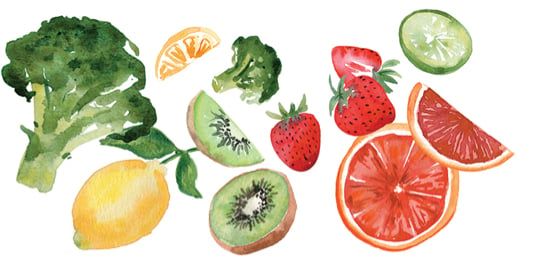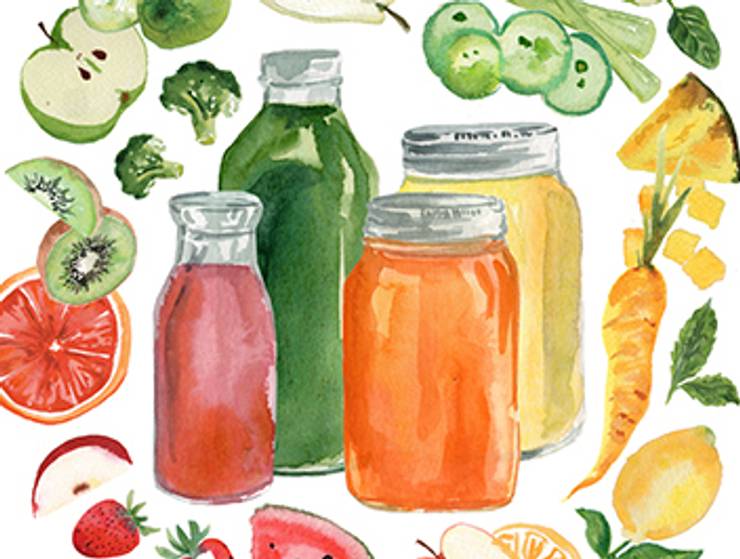Articles
Juicing Series Part 4: A Realistic Look At The Health Benefits of Juicing
Can Drinking Fresh Juice Support You?
Juicing can be a controversial topic. Some experts have dubbed it as “bad” because of the sugar content, while others claim juicing is the cure to almost anything.
When it comes to nutrition, some people love to gravitate toward an “all or nothing” mentality for attention-grabbing headlines, but the truth often lies somewhere in the middle. To begin, let’s define juicing.
Juicing, Defined
Juicing is the process of extracting the juice from fresh fruits and/or vegetables with a juicer or blender. This process should not be confused with a juice fast or cleanse, which is involves consuming solely juices for an extended period.
Now that we’re on the same page, back to the topic at hand… how can drinking more fresh juice benefit you? Well, first, no foods are inherently “bad.” It’s typically what how we prepare or process food that makes it “unhealthy.” Let’s look at benefits and risks to figure this out.
A Look At The Benefits
Longevity & less disease. Juice is packed with vitamins, minerals, phytonutrients and antioxidants which can add a high concentration of anti-inflammatory nutrients to the diet. Recent recommendations from The American Heart Association reveal that the right ‘five- a- day’ mix is two fruit and three vegetable servings to help increase longevity. However, the CDC reported in 2017 that only one in ten Americans meet the federal recommendations for fruit and vegetable intake. Some people who are not used to eating fruits and vegetables can find achieving the recommended intake challenging, but consuming more fruits and vegetables is associated with decreased risk of disease and death. Additionally, eating foods rich in polyphenols, may have a protective effect against diseases such as cancer, atherosclerosis and type 2 diabetes. Juice can be a great way to add in more nutrients from fruits and veggies. However, it’s important to note that people should still aim for the servings per day of whole fruits and vegetables that experts recommend, as this also helps to provide fiber.
Easy on the gut. A fresh made juice is easily digestible and absorbable. The digestive system doesn’t have to work as hard to break down the fiber in your food, which can allow increased bioavailability of phytochemicals and antioxidants. In addition, the polyphenols provided from fruit and vegetable juices may contribute a prebiotic effect on the gut. Prebiotics promote an environment for healthy microbiota to flourish.
Improved energy & hydration. Juice can be a quick source of energy because the body absorbs, and can use, the sugar it contains easily. For those exercising at an athletic level, consuming fluids containing electrolytes and carbohydrates, such as juice, can also be a great way to stay hydrated. Additionally, for those people who don’t like drinking water, adding a small amount of juice may make staying hydrated more palatable.
Support natural detoxification. Phytochemicals derived from different produce can support the production of enzymes, which aid the body in its natural ability to detox and combat oxidative stress and inflammation.
Know The Potential Risks
Don’t replace food with juice. Juice cannot replace whole fruits and vegetables in the diet because you can easily lose the benefits of fiber. In addition, juice alone is very low in calories and does not provide adequate amounts of protein or fat in the diet if someone is consuming juice exclusively.
Juice fasting with underlying conditions. Certain groups of people dealing with underlying health conditions do need to consider how they juice. As an example, for someone with diabetes or uncontrolled blood sugars, consuming too much juice could potentially lead to hyperglycemia or reactive hypoglycemia. However, pairing juice with enough fibrous foods or proteins can help to prevent a spike in blood glucose and rise in insulin. Consider making a juice with more vegetables and less fruit (aim for ½-1 cup/piece of fruit per 16-ounce serving of juice) or adding a scoop of plant-based protein powder or a teaspoon of plant-based oil like flax or avocado directly to your beverage. Someone with end stage kidney disease must limit their total daily fluid and potassium intake. In one case study published in The American Journal of Medicine, a patient with Stage 3 kidney disease suffered from oxalate nephropathy following a six-week juice fast. For most people, the risks of adding juice to a balanced diet are low.
High sugar content. Be wary when buying juice at the store, as you will often find juices with added sugars. The sugar content in juices with added sugars is comparable to the sugar in fizzy soda drinks. The Dietary Guidelines for Americans advises people to limit added sugars to less than ten percent of their calories per day. To avoid added sugars, take time to read labels.
In summary, consuming fresh juice as part of a healthy diet may have health benefits associated with the vitamins, minerals and phytonutrients from the fruit and veggies. Juice can provide a quick source of energy and may support a healthy gut. Don’t forget to continue to eat the recommended amount of whole fruits and vegetables per day so you include adequate fiber in your diet.
Consuming juice exclusively restricts other food groups and may cause a deficiency in essential fats and protein. People who have a health condition such as diabetes or kidney disease should speak to their doctor if they are considering adding juice to their diet.

What is the best way to juice? Let’s Compare.
Juicer: A juicer will make life a lot easier if you’re going to be juicing regularly, but also offers some additional health benefits. Unlike centrifugal or rotary juicing, which generates heat and accelerates oxidation of the produce, cold press juicers gently extract juice from produce by applying pressure. A Nama Cold Press Juicer slowly extracts juice to minimize oxidation, preserving the integrity of the vitamins, minerals and phytonutrients inside.
Blender: If you’ve got a high-speed blender, blending produce is an option. However, blending will retain the pulp, which includes insoluble fiber. Insoluble fiber is important in the diet, as well, but to juice you’ll need to then strain the pulp manually.
Store bought: Buying juice can be convenient, but the cost can add up over time. Mass-produced juices on the shelves of your local grocery store are often pasteurized, killing pathogens and extending shelf life. But the high heat involved may also destroy some of the desired nutrients in the process. If you are out and about and want to grab a juice-to-go, look for juices which state “cold-pressed,” “cold pasteurized,” or “high-pressure processed” (HHP) on the label. Also, check the label for added sugars or additives such as colorings.
Tips To Add More Juice To Your Diet
|
|
Happy Juicing!
Danielle DeGroot is a Registered Dietitian and owner of Dietitian Gone Wild Virtual Health Coaching. You can follow along with or get in touch with Danielle on Instagram at @dietitiangonewild.
by: Danielle DeGroot
Article - February 2022
- Choosing a selection results in a full page refresh.
- Press the space key then arrow keys to make a selection.

